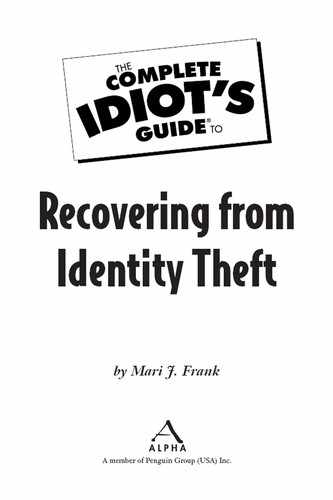Get the Documentation
Every step of identity recovery uses documentation, the fundamental source of the information that will help you recover your identity. As I mentioned in Chapter 2, one important source of information will be talking to people and documenting the conversations in letters and your log, but the most important resources will be the records that organizations keep. The written information will help you in a number of ways:
♦ Proving that you were the victim of identity theft
♦ Tracking down how the identity theft occurred
♦ Finding additional sources to help you recover your identity
♦ Showing how an organization may be financially responsible for the results of the identity theft
I’m going to give you an overview of the records that you’ll need most in recovering your identity. Other chapters will tell you how to get and interpret them. I’m going to break this information down into two categories: financial and other.

Identity Crisis
These records are necessary, but may not show the full extent of the documentation you’ll eventually need if the fraudster has created new credit accounts, utility accounts, apartment leases, bank accounts, or other fraud in your name. Later in this chapter, I explain how to create a plan of attack to deal with such problems.
Financial
The financial industry keeps extensive records, so you can get the details that will help you investigate your case of stolen identity. About 80 percent of identity theft is financial in nature, so records from financial institutions will be the most important documents for investigating and resolving your case of identity theft.
♦ Credit reports
♦ Credit-card statements
♦ Bank statements
♦ Investment accounts
♦ Insurance policies and accounts
♦ Service accounts
Credit reports are documents kept by CRAs that will likely become the most powerful tool you have to investigate your identity theft. They show who inquires about your credit record, which entities have granted credit in your name, and which organizations are reporting problems getting credit payments from you. Chapter 4 covers credit reports and how to work with them in detail.

Information = Power
If you stop getting any regular financial statements, including those from credit-card companies, your bank, cell-phone service providers, or utility companies, it’s a strong indication that someone might have stolen your identity and changed the address that the company has for you.
Your monthly credit-card statements show what was charged, when it was charged, and what organizations placed the charges when the thief used your credit-card number. Chapter 5 covers how to handle credit-card problems.
Your monthly bank or financial institution statements offer the best indicator of whether someone has committed check fraud, debit-card fraud, fraudulent wire transfers, or some other fraudulent activity. You’ll know because debit memos will be listed on the statements. Chapter 7 has the details on how to get them. Statements from investment accounts will show if someone has sold some or all of your portfolio and taken the money. Look at Chapter 7 for more details.
You’ll also want any documents relating to insurance policies and accounts. A criminal could try to cash out certain types of life insurance policies, file a fraudulent claim on a policy, or change the coverage of a policy in anticipation of a fraudulent claim. Chapter 8 tells you how to get the records. Health insurance is in the category of medical records, which I mention later in this chapter.
Also check records from service accounts such as cell-phone providers and utilities, which regularly bill you for service, to see if account information has changed or if there are unexplained charges. Chapter 8 has information on these.
Other Records
This category is a grab-bag because of the variety of records that might be important. Look through all of them to see what could apply.
♦ Social Security PEBES: Getting your personal earnings and benefit estimate statement from the Social Security Administration can alert you if the thief is using your Social Security number at a job and potentially leaving the Internal Revenue Service bill for you. Go to Chapter 12 for details.

Legal Lingo
A personal earnings and benefit estimate statement (PEBES) is a form that the Social Security Administration sends you to show the history of earnings it has on record for you by year and an estimate of the resulting future Social Security benefits. Any earnings that you don’t recognize may be the work of an impersonator.
♦ Criminal identity theft and background checks: Identity thieves are often involved in other sorts of illegal activity, which can create law-enforcement havoc. Some fraudsters, when arrested in another crime, will give your name to keep charges from going on their own records. You’ll need to do a background check on yourself to ensure that you haven’t been made the target of law enforcement. The details of how to get a background check and how to handle criminal identity theft in Chapter 15.
♦ Public records checks: These records show you what public records are associated with your name, including lawsuits, birth records, and licenses.
♦ Online records: Cyber identity theft is one of the fastest-growing areas because it gives crooks more ways to take other parts of your personal identity, or even the identity of your business. Online records could include social-networking accounts, accounts with Internet service providers, and websites that mention you or your business. Because there can be so many sources of information to check, you should look at Chapter 17 for some details of how to proceed.
♦ Medical records: Medical identity theft, like criminal identity theft, is a category largely unto itself, because there aren’t established steps to remedy the problem in the same way as with financial identity theft. If you have any indication that your medical identity has been stolen, like getting bills or collection calls for medical procedures you never had, you’ll want to check health insurance and medical records. Chapter 14 explains how.
..................Content has been hidden....................
You can't read the all page of ebook, please click here login for view all page.
